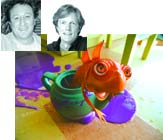
Animators at Stan Winston Studios used Softimage|XSI to create the film's CG crab.
|
HOLLYWOOD - Dr. Seuss' The Cat in the Hat, an 82-minute Universal Pictures/DreamWorks and Imagine Entertainment co-production, features the talents of funny man Mike Myers as the mischievous Cat who instigates mayhem in a visually vibrant world of stylized live-action footage, which is seamlessly integrated with over 700 visual effects shots.
VISUAL EFFECTS
Los Angeles-based Rhythm & Hues (www.rhythm.com) was brought on board as the main visual effects company, and academy award-winning visual effects wiz Doug Smith (Independence Day, Dr. Dolittle 2) served as the film's primary visual effects supervisor. "The company was chosen," says Smith, "because we have the experience working with animals and doing humorous movies, like Cats and Dogs and Scooby-Doo, so they felt we might be a natural for doing the fish character."
PREVIS
During pre-production on The Cat in the Hat, Ron Frankel's mobile pre-visualization company Proof Inc. (www.proof-inc.com) took a set of computers with Nvidia G-Force cards running Softimage|XSI and set them up right in the art dept on the Universal lot.
In one case there were a set of effects shots in need of CG set extensions that budgeted high. "When we looked at the shots in the previs it showed that the extensions just covered a sliver of the frame," says Frankel. "So instead of taking a budget and spreading it across a lot of effects shots, the previs gave us the strategic information to reframe those shots without extensions and instead use the money to do five big CG shots."

Rhythm & Hues' Craig Talmy, Doug Smith (L-R) and crew were charged with giving this CG fish its intensity of emotion.
|
DIGITAL DAILIES
The Cat in the Hat embraced an all digital dailies system for post production, says associate editor Sean Albertson. The principal camera negative was transferred on a Spirit DataCine to D-5 HD first at Hollywood Digital (www.hollydig.com) and later at Burbank's Matchframe Video (www.matchframevideo.com).
As the D-5 master is being run, a simultaneous stream is going to the master Avid Unity system, says Matchframe president Rand Gladden. That media bin is pulled off the system and put on either FireWire drives or DVD-ROM discs and then sent to feature editorial.
At Universal's digital theater, the D-5 HD dailies were screened each day from a Panasonic AJ-HD3700 fed to a Christie DLP and projected on a 30-foot screen. "Everyone was pleased with the convenience. Rewinding a tape is easier than rethreading film," says Ronald Martin, VP of Universal's Digital Video Compression Center.
THE FISH
With the fish character, Rhythm & Hues got the opportunity raise their CG animation skills a notch higher. "The direction from Bo Welch," says lead animator Craig Talmy, "was that the personality of the fish is about enforcing rules. So it started coming out as Tony Randall's rendition of Felix Unger and mutated to Don Knotts' Barney Fife intensity of emotion."
According to Talmy, the goal of the animation was "how to achieve subtlety of expression and emotion considering you have a fish with just a face, eyes and mouth and no body. We fortunately had the time to create a very robust set of [virtual] control rigs inside the fish, a lot more control than your standard character."
"On the technical side it was very complex," says Smith, because of the interaction of the fish, the bowl and the water. "The fish had a shiny gel layer that had subtleties with skin texture where it reflected the environment that it was in. We used a high dynamic range imaging HDRI process to scan the environment and use that data as reflection maps on the fish," continues Smith. They used proprietary software to create the fish.
THE CRAB
At Stan Winston Studios (www.stanwinston.com) lead animator Randall Rosa crafted the "crab lock" character in Softimage|XSI. "What we brought to the table is our pipeline," says Rosa. "Stan is very sensitive to the marriage of CG and live-action physical effects. Fundamental to our CG production process is using the higher-end rendering techniques." For example, he explains, the use of "final gathering" within the Mental Ray engine, which creates extremely realistic shading effects.
DIGITAL INTERMEDIATES
As the preview master cut was being built, Efilm Digital Labs (www.efilm.com) concurrently assembled the final digital intermediate. They first rescanned the select shots on their Imagica XE scanner at 4K, then interpolated down to 2K. "It's the best way to get the full dynamic range off the camera negative," says Efilm's digital intermediate colorist, Steven J. Scott.
Then the principal photography files and visual effects Cineon files were loaded into Efilm's proprietary editing/compositing and color grading system. Scott explains that Efilm has fine tuned the 3D color space on their Barco projector to best emulate what the movie will look like on film.
What's nice about having their proprietary system, he says, is that for The Cat in the Hat they were able to create a custom set of tools for cinematographer Emmanuel Lubezki to isolate sections of Mike Myers' face and smooth out his make up yet retain the fine detail in the eyelashes.
For an extended version of this story, please go to www.postmagazine.com.